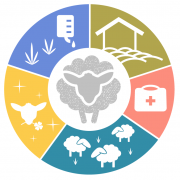Online Trainings: Sheep Welfare in Wool Production
Online Trainings: Sheep Welfare in Wool Production
In December, the animal welfare organisation FOUR PAWS and the Dutch Agreement on Sustainable Garment and Textiles (AGT) organised a training on Sheep Welfare in Wool Production. The workshop resulted in three online trainings on responsible wool production. The three videos are helpful for textile and clothing companies.
Rebecca Picallo Gil, campaign manager and project manager of Wool With a Butt at FOUR PAWS, kicks things off. She introduces the topic of animal welfare and animal protection in sheep farming. Best practices in wool production are also addressed. Fashion brands should only source wool from sheep that are kept without mulesing (see info box).
Video link (41 minutes)
In the second video, Nicolas Allen, Senior Traceability and Animal Welfare Manager at Patagonia, presents the requirements the outdoor brand places on its wool. For example, all suppliers of virgin wool must be RWS (Responsible Wool Standard) certified and comply with the Patagonia Wool Standard (PWS).
Video link (31 minutes)
In the third part of the online training, Willi Gallia presents the work of the Schneider Group. He is Chief Sustainability Officer at the Italian family-owned company. The Schneider Group procures, processes, trades and produces animal fibres, especially wool and cashmere. In the process, the company uses only mulesing-free wool and relies on labels such as RWS and GOTS.
Video link (27 minutes)
Animal welfare and protection
Das Textilbündnis erkennt Schurwolle als nachhaltig an, wenn sich die Halter an die „Fünf Freiheiten“ halten und auf Mulesing ihrer Tiere verzichten. Alle Mitgliedsunternehmen, die Schurwolle verwenden, sind dazu verpflichtet, eine Policy zu veröffentlichen, in der sie Mulesing ablehnen: Sektorrisiko Tierwohl
Five Freedoms
The Five Freedoms were defined on the basis of the 1965 Brambell Report. They are used to determine whether and which animal welfare requirements are met. In order to establish an internationally accepted basis for animal welfare in agriculture, the Farm Animal Welfare Council (FAWC) published five basic requirements in 1993/94, which have become known as the "Five Freedoms". These requirements form an important basis for animal welfare today, regardless of the animal welfare regulations of the respective country. They represent the ideals of animal welfare and are to be understood as keeping animals "as free as possible from" the negatives mentioned in these principles.

- Freedom from hunger, thirst and malnutrition. The animals have free access to water and receive species-appropriate food to ensure health and vitality.
- Freedom from discomfort: The animals are kept in an animal-friendly environment.
- Freedom from pain, injury and disease through prevention or rapid diagnosis and treatment.
- Freedom to act out normal behaviour: Keepers provide sufficient space and species-appropriate facilities and keep the animals together with conspecifics.
- Freedom from fear and suffering: The animals are kept and treated in such a way that psychological suffering is avoided.
Mulesing
Often sheep are affected by a heavy fly infestation. To deal with this problem, a surgical procedure called "mulesing" emerged about ninety years ago. In this operation, parts of the skin around the tail of sheep are removed - in many cases without painkillers or anaesthesia. Smooth scar tissue forms at the wound where blowflies can no longer lay eggs. Mulesing is strongly criticised by animal welfare organisations. In New Zealand, the practice has been banned since 2018. Australian sheep farmers actually wanted to phase out mulesing by 2010, but the practice is still common. The alternative to mulesing means that the animals must be examined frequently to determine whether fly infestation is present. If so, the affected animal must be treated. This procedure is much more labour-intensive than mulesing.


